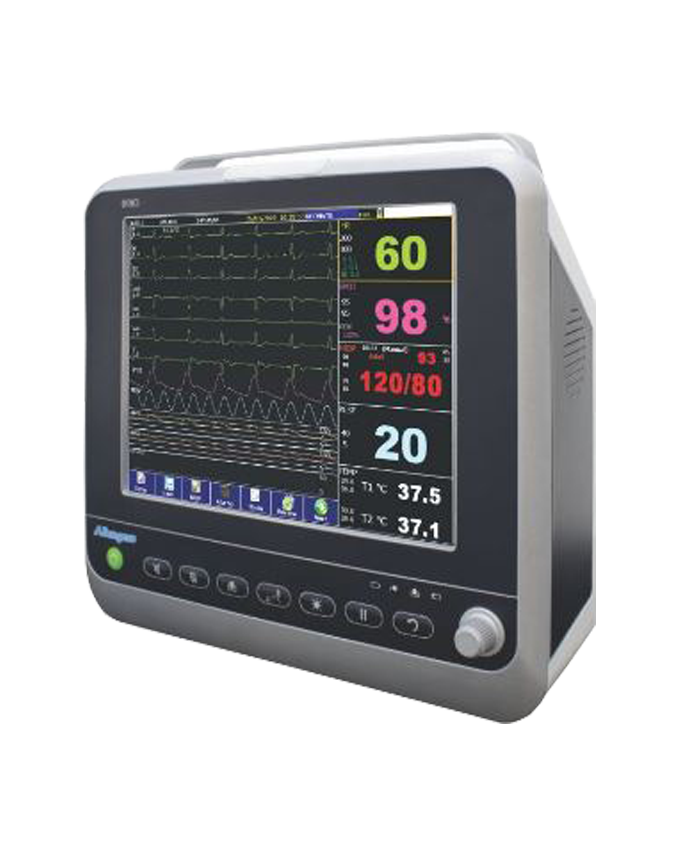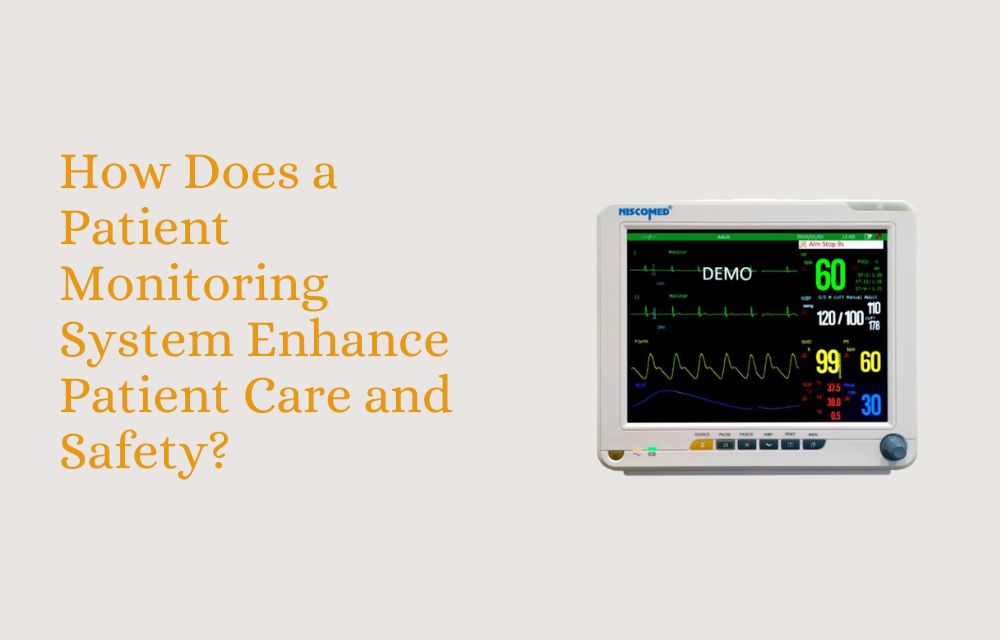One of the most effective tools helping doctors and nurses provide safe and timely care is the patient monitoring system. These systems allow healthcare professionals to track a patient’s health in real-time, ensuring they can respond quickly to changes in the patient’s condition. But how exactly does a patient monitoring system enhance patient care and safety? Let’s take a deeper look.
What is a Patient Monitoring System?
A patient monitoring system is a type of technology used to measure and track a patient’s vital signs, such as heart rate, blood pressure, temperature, respiratory rate, and oxygen levels. These systems provide continuous monitoring of a patient’s health status, ensuring that any potential issues are detected early, allowing healthcare professionals to intervene when necessary.
Features of Patient Monitoring Systems
- Real-Time Monitoring: Constantly tracks a patient’s vital signs and displays them in real-time.
- Alerts and Alarms: Sends notifications if any vital signs fall outside the normal range.
- Data Recording: Saves health data for future reference, which helps in tracking trends and changes over time.
Patient monitoring systems are used in various healthcare settings like hospitals, emergency rooms, intensive care units (ICUs), operating rooms, and even for remote patient monitoring.
How Patient Monitoring Systems Improve Patient Care
1. Continuous Monitoring of Vital Signs
One of the main benefits of a patient monitoring system is its ability to provide continuous monitoring of a patient’s vital signs. Unlike manual checks that are done at fixed intervals, these systems track vital signs 24/7, providing a constant flow of information to healthcare providers.
Why It Matters:
- Continuous monitoring ensures that healthcare providers can detect any changes in a patient’s condition as soon as they occur. This helps prevent complications from being missed and allows for immediate intervention if necessary.
- For patients in critical condition, such as those in an ICU or recovering from surgery, this constant monitoring is crucial to keeping them safe and stable.
Example:
For a patient in intensive care, a patient monitoring system continuously tracks their heart rate, blood pressure, and oxygen levels. If there’s a sudden drop in oxygen levels, the system sends an alert to the nurse so they can act quickly to address the issue.
2. Early Detection of Health Problems
With real-time data from patient monitoring systems, healthcare professionals are able to detect health problems much earlier than if they were relying on occasional manual checks. Early detection is key to preventing conditions from worsening and can significantly improve patient outcomes.
Why It Matters:
- Detecting health issues in the early stages, such as low blood pressure or irregular heartbeats, allows healthcare providers to address these problems before they become serious emergencies.
- Early intervention leads to better recovery rates and lower risk of complications, which ultimately saves lives.
Example:
If a patient’s blood pressure suddenly spikes, the system will immediately alert the doctor, allowing them to adjust medications or take other measures to stabilize the patient.
3. Real-Time Alerts for Immediate Action
Another key benefit of patient monitoring systems is the real-time alert system. When vital signs fall outside of the safe range, these systems automatically send alarms to the healthcare team. These alerts help doctors, nurses, and other medical staff respond quickly and make timely decisions about patient care.
Why It Matters:
- Immediate alerts allow healthcare professionals to act faster, improving patient safety and minimizing the risk of harm.
- Timely action is crucial in critical care settings where even a few minutes can make a big difference in the outcome.
Example:
For a patient undergoing surgery, the system will alert the surgeon if there is any sudden drop in heart rate or oxygen saturation, enabling them to take quick action to ensure the patient’s safety.
4. Improved Decision-Making with Data
The data collected by patient monitoring systems helps healthcare professionals make informed decisions about a patient’s care. With accurate, up-to-date information, doctors can adjust treatments, medications, and interventions based on real-time health data.
Why It Matters:
- Continuous access to detailed health data means healthcare providers are never in the dark about a patient’s condition.
- This leads to better, more precise decision-making and personalized care, as treatments can be tailored to the patient’s changing needs.
Example:
A patient in the recovery room might have fluctuating blood pressure, which the monitoring system tracks over time. The doctor can use this data to adjust medications or take additional measures to stabilize the patient.
5. Enhanced Patient Safety During High-Risk Procedures
In high-risk situations such as surgeries, intensive care, or while patients are under anesthesia, a patient monitoring system plays a vital role in maintaining patient safety. These systems track multiple vital signs at once and alert the medical team of any potential risks.
Why It Matters:
- In high-risk procedures, where patients may be unconscious or unable to communicate, constant monitoring ensures that any changes in their health are detected immediately.
- This improves safety by allowing healthcare teams to respond quickly to complications and prevent emergencies before they occur.
Example:
During surgery, a patient monitoring system can keep track of the patient’s heart rate, blood pressure, and oxygen levels. If any of these readings become abnormal, the system alerts the surgical team, who can adjust anesthesia or take other necessary actions to protect the patient.
How Patient Monitoring Systems Contribute to Long-Term Care

1. Remote Patient Monitoring for Chronic Conditions
Patient monitoring systems are not limited to use in hospitals. They are also helpful for patients with chronic conditions who need regular monitoring even when they’re not in the hospital. These systems allow healthcare providers to remotely monitor patients from the comfort of their own homes, ensuring they stay on track with their treatment plans.
Why It Matters:
- Remote monitoring reduces the need for frequent hospital visits, saving both patients and healthcare systems time and money.
- Patients with chronic conditions, such as heart disease or diabetes, benefit from having their vital signs monitored regularly to manage their conditions more effectively.
Example:
A patient with heart disease might wear a device that continuously monitors their heart rate and blood pressure. If the system detects any concerning changes, the doctor is alerted and can reach out to the patient for further assessment or treatment adjustments.
2. Increased Comfort and Independence for Patients
By enabling healthcare providers to monitor patients remotely, patient monitoring systems help patients feel more independent and comfortable. They don’t have to stay in the hospital for constant checks, yet they can still receive high-quality care.
Why It Matters:
- Monitoring systems help patients feel less anxious about their health, knowing that they’re being closely watched even when they’re not physically in the hospital.
- Remote monitoring also allows patients to live more normal lives, which can have a positive impact on their overall well-being.
Example:
A patient recovering from surgery can use a wearable device to monitor their heart rate and blood pressure at home. Their healthcare provider can check the data remotely, making sure they’re healing properly without the patient needing to visit the hospital.
3. Better Coordination Among Healthcare Providers
Patient monitoring systems allow data to be shared seamlessly across different healthcare departments. This means that doctors, nurses, and specialists can work together more effectively, as they all have access to the same patient data.
Why It Matters:
- Improved communication between healthcare providers ensures that everyone is on the same page, leading to better-coordinated care.
- When all healthcare providers have access to the same data, patients are less likely to experience errors, duplications, or delays in their treatment.
Example:
If a patient is transferred from the ICU to a regular ward, the same monitoring system can be used to continue tracking their health. The new medical team can review the patient’s data in real-time, ensuring continuity of care.
Conclusion
A patient monitoring system is an essential tool for improving patient care and safety. By providing continuous monitoring, early detection of health problems, and real-time alerts, these systems help healthcare professionals make informed decisions and respond to critical situations quickly. They not only improve patient outcomes in hospitals but also support long-term care for patients with chronic conditions.
As healthcare technology continues to evolve, patient monitoring systems will remain a key element in delivering high-quality, safe, and effective care. Whether in the hospital or at home, these systems are changing the way we approach healthcare, offering a brighter and safer future for patients and medical providers alike.
Note:- To read more articles visit on writefortourism

